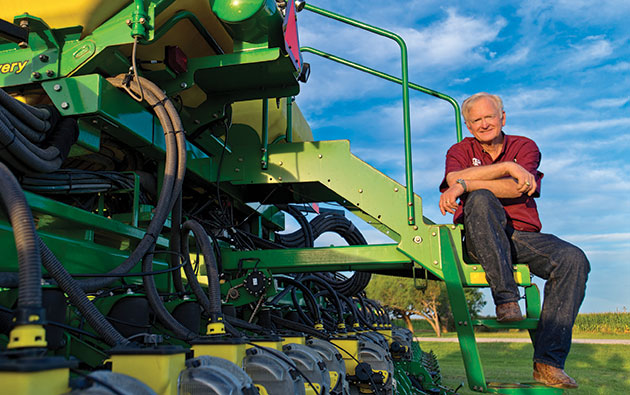
Jimmy Dodson
Photo by Eddie Seal
Winter is a busy time for farm meetings, and no one knows that better than Jimmy Dodson of Robstown, Texas. As board chairman of the Farm Credit Bank of Texas since 2012 and past chairman of the National Cotton Council and other cotton organizations, the South Texas farmer is on the go all winter long, hopscotching across the country to represent the interests of his fellow farmers.
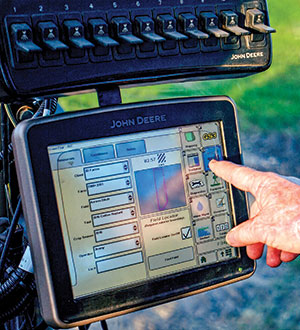
Winter is also planting time on his 12,600-acre farm, just outside Corpus Christi on the Texas Gulf Coast, and come February Dodson makes it a priority to spend as many days as possible in the tractor cab.
Forty years ago, he might have put his farm leadership activities on hold during planting season. But thanks to advancements in technology — a tractor with tinted windows, GPS and auto-steer that can be programmed to do its job precisely — today Dodson is able to conduct business on his cellphone, check markets on his iPad and even draft his next speech while planting cotton, milo and corn. Moreover, the farming activities are handled with greater efficiency than ever before.
"It was hard to operate a tractor with only an umbrella for long hours in the South Texas heat," he says with a chuckle, recalling farming practices a generation ago. "I wouldn't look forward to that now."
To say that much has changed since Dodson began farming in 1974 would be a vast understatement.
Back then, he was just 21 and married, with a freshly minted diploma in agricultural economics from Texas A&M University. He had plans to enter the agribusiness field, but his father had the chance to lease a retiring neighbor's land and purchase his equipment, and needed a partner. The younger Dodson asked, "What about me?"
That conversation launched a career that has placed Dodson at the leading edge of agribusiness trends and techniques, where he is a respected innovator among his peers.
Second-Generation Farm Credit Customer
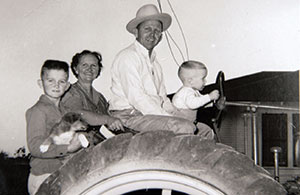
Courtesy of the Dodson family
A young Jimmy Dodson at the tractor steering wheel with his brother and parents
Before he and his dad formed the partnership, Dodson's parents had farmed 1,400 acres with two employees, three tractors, three planters and plows, a combine and a small cotton picker.
"They owned their own home, helped put their four kids through college and made a good living," he says. "About the time I was born — in the middle of the drought of the '50s — my dad began financing with Farm Credit, and they helped him to be successful."
When Dodson joined the business, he and his father doubled the size of the operation to 2,600 acres of cotton and grain sorghum to support both families. Farm Credit made the partnership its first loan.
The timing couldn't have been better.
"President Nixon had let the dollar float, commodity prices were high and production costs low," Dodson recalls. "I felt like I could make a living on my share."
To handle the expansion, they added three employees, three tractors and three planters — none with a cab, he notes.
"There was no GPS, and we didn't have great lighting on the gear when we worked late during harvest," Dodson says. "But, the net back then was a lot better on both per-unit and per-acre basis."
Forty years ago, a new pickup sold for $4,700, grain sorghum brought $6 per hundredweight, fertilizer cost $100 per ton and diesel cost 25 cents per gallon.
"Today, a pickup costs 10 times that; it's rare to get those prices on grain sorghum; fertilizer is $250 to $350 per ton; and labor costs are at least six times as much as then," Dodson figures.
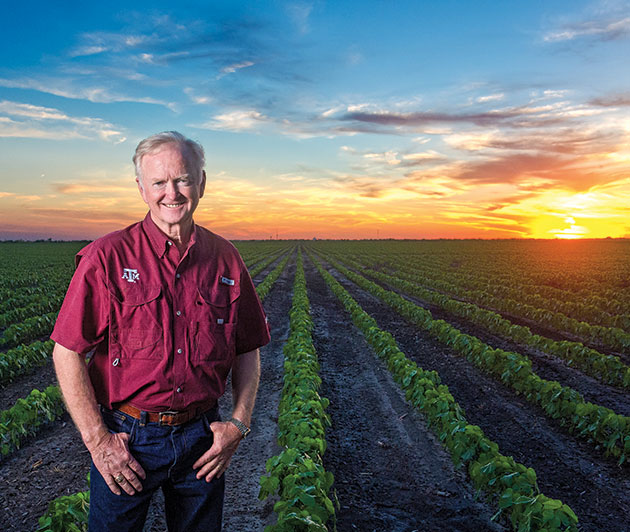
Jimmy Dodson in a field of young cotton on his Robstown, Texas, farm, which he operates with his wife, Barbara, daughters Lori McDonald and Licia Massa, and cousin Jon Gwynn
Photo by Eddie Seal
Embracing New Technology
To maintain about the same living standard for two farm families today as in 1975, the Dodsons now cultivate almost 10 times more land, but do so with the same number of employees — six.
"The big difference is equipment that can cover the ground fast and more precisely, and technology that improves pest, weed and disease control," Dodson says.
While adopting and investing in technology is a decision each producer must make, Dodson says most farmers opt for improved risk management. Not only does today's planting and harvesting equipment provide more capacity and efficiency, it also offers operators creature comforts not available in earlier versions. Previously, planting and cultivating operations required constant focus on maintaining the row path.
"Now we are able to set our equipment precisely in relation to the seedbed or row of plants, be in a very comfortable cab, and cover 12,000 acres of work with six people or fewer," he says. "The capacity is just amazing, the operator stress is diminished, and all the work is more precise."
Applying GPS technology has been a game changer for much of production agriculture. GPS-enabled farm equipment today can digitally remember the paths made through the field from one season to the next. The result is less soil compaction and overlap. Necessary tillage is limited to the seedbed, where the depth of the seed can be pinpointed within a quarter of an inch, and the quantity and spacing of seeds can be adjusted on the fly based on soil conditions and productivity.
"Our system counts every seed and tells us within a 1 percent range what we have planted in each row, and it electronically maps an individual field as to seed population and variety," Dodson says.
From his iPad, he can monitor equipment in the field, note when a machine is having a service or performance issue, and get online manufacturer support to find a solution in real time.
Using their GPS tools, the field team applies fertilizer accurately to within 1 inch of the seed. By field mapping before farming operations begin, they can plan and control seed population shifts, fertilizer rates and crop-care products to reduce inputs and maximize yields.
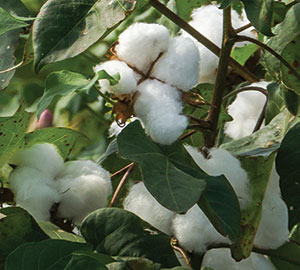
Photo by Kanokwalee Pusitanun
Technology's Many Benefits
The precision and the advancements in pest management and soil conservation are a win for both the pocketbook and the environment, Dodson notes.
"We are reducing tillage and improving the soil, and by eradicating the boll weevil, we've been able to reduce pesticide use dramatically. Moreover, top yields have doubled," he says. Pesticides and herbicides are much more environmentally friendly now and targeted at specific pests. New technology promises improvements in the taste, nutrition and shelf-life of food crops and the comfort and performance of cotton products, as well.
"We already are able to produce more food and fiber than ever before, and our carbon footprint per unit produced is many times smaller than when I started farming — and is trending down further," he says.
"Few industries can match that positive environmental record, and food and fiber costs are the lowest in history."
Unmanned aircraft, or drones, are another example of agricultural technology.
"Drones can be equipped with sensors to look down through a crop canopy and count how many bolls of cotton are in a field — or look into an orchard and count the number of oranges on each tree — and then accurately screen for plant pests and measure plant health, giving management information that was unimaginable in the past," Dodson says.
For ranchers, drones can play a key role in looking for newly dropped calves and strays. Dodson predicts that in the future, farmers will use drones to identify pest problems and then will treat specific weeds or infestations with herbicide directly from the drone, eliminating the need to spray large areas or whole fields.
Farm Credit Advances With Agriculture
As the business of agriculture has advanced, so too has the financial partner to the agricultural industry, the Farm Credit System, says Dodson. A customer-owner of Texas Farm Credit since 1974, he became the youngest-ever Production Credit Association director in the state at age 28.
"We already are able to produce more food and fiber than ever before, and our carbon footprint per unit produced is many times smaller than when I started farming — and is trending down further."
– Jimmy Dodson
"When I started, Farm Credit offered producers expertise, understanding and a strong relationship, but often it was quite an exercise to apply for a loan, especially if different loan products were needed," Dodson recalls. "There was a lot of paperwork required, and at that time lenders had limited loan-making authorities that made one-stop service impossible. If borrowers needed land loans and short-term credit, one Farm Credit association could seldom offer both.
"Borrowers had to double their paperwork if they wanted a loan product not offered by their existing Farm Credit lender, since the System structure made it hard to share borrower information or collaborate, and loan turnarounds and answers weren't always prompt."
Contrast that to today.
"Now our federated ACA [Agricultural Credit Association] structure and customer focus allow eligible borrowers' needs to be met fully, no matter the loan type, size or complexity," he says. "Borrowers can get the best ag expertise, ready answers, state-of-the-art funding, competitive pricing and the valuable benefits of being a stockholder of their association — all at one office with one relationship."
"My hope is that many generations of producers and rural communities in years to come will prosper by knowing and joining the Farm Credit family …."
– Jimmy Dodson
Agriculture and rural communities are changing at a rapid pace, and Farm Credit has heightened its customer focus to meet evolving needs. Today, Farm Credit cooperatives collaborate to use their lending authorities to finance rural broadband services and utilities in underserved communities, as well as small and specialty niche food operations. Farm Credit housing loans now span everything from home improvements to barndominium construction.
But, Dodson says, "There are still those who are eligible for Farm Credit loans and service, and yet don't know about us. We have a great story to tell and much to offer. Every new member and every community served represents hope and dreams that can come true."
Feeding Future Populations
What lies ahead for agriculture?
Dodson has an optimistic view, tempered by reality. The developing world will continue to need a steady food supply, and more and more people will gain purchasing power, allowing them to eat more and better foods.
"There's not enough land to feed all the people unless we deploy improved technology, innovate more and keep farmers on the land with profitability and sound policy," he says. "We are very efficient, but a reasonable food policy that supports American farmers is key to keeping agriculture progressing."
Dodson says that Farm Credit will continue to play a key role in financing the evolving agricultural sector, just as it has been critical to his own farming success.
"Farm Credit has walked with us every step of this journey. The people that make up the Farm Credit team are the most able and prepared I've ever known; our products and organizations are better than ever; and our mission is clear," Dodson says.
"My hope is that many generations of producers and rural communities in years to come will prosper by knowing and joining the Farm Credit family, and will use their ownership and influence to keep the cooperative system healthy and able to serve."
– Sue Durio